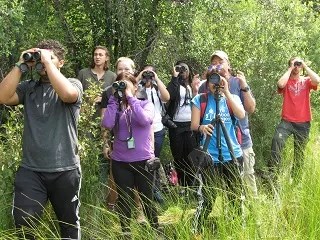Part of a series of articles titled Junior Ranger - Lake Roosevelt National Recreation Area.
Article
Junior Ranger: Botany By The Bay

So, how can you begin your study of botany? Super easy! Find a plant. Any plant will do - live or dead, as long as it is something that gets you to ask a question. It could be as simple as 'is it alive?' or 'what kind of flower is that?' or even 'should I touch that?' For some plants it is better to leave it alone and make a drawing or model of it. For others, especially common plants where there are many growing in an area, it may be okay to pick one to press for your plant journal.
For us, it's important not to pick any plants in the park. We want to leave them for other visitors to enjoy. So, if you're ready to study plants, please find some in a yard or other area that are okay for you to pick. A plant press is used to keep the plant dry, flattened, and preserved for studying later.
Let’s create a simple Plant Press!
Materials:
- A hard, flat surface
- 2 cardboard pieces (same size as a large book)
- 2 pieces of newspaper or paper
- Heavy books
- Plants
- Build plant press starting from the bottom:
- Hard flat surface
- Cardboard
- Paper
- Plants (arranged how you’d like them to be pressed, try and imagine them flattened)
- Paper
- Cardboard
- Heavy books
- Leave plant press for five to ten days.
- Remove the stack books and items to reveal your pressed plants. Be careful! The plant could be delicate.
Once you have one or two plants in your press, you can start making your journal. This is where you can keep your notes, sketches, and the pressed plants from your explorations.
An alternative to a sketch journal is an audio journal. You can use a voice recorder, a camera with video capabilities, or a smartphone to record your observations about the plants. What other questions can you answer about the plants if you use this method?
Botanist Journal
Materials:
-
Notebook
-
Paper
-
Glue or tape
-
Markers
Directions:
-
Before pressing your plants. Record the time, date, location, and name of plant.
-
Press your plants in the previous activity.
-
After plant has been pressed, glue or tape the plants to the pages of the notebook.
-
Add the details you recorded about the plant, like where you found it, color, size, etc to the page.
If using glue, make sure the page has dried before making the next one and stacking it on top. Collect and identify as many plants as you can in your backyard or neighborhood.
Congratulations, Junior Botanist!

NPS
Last updated: April 20, 2022
